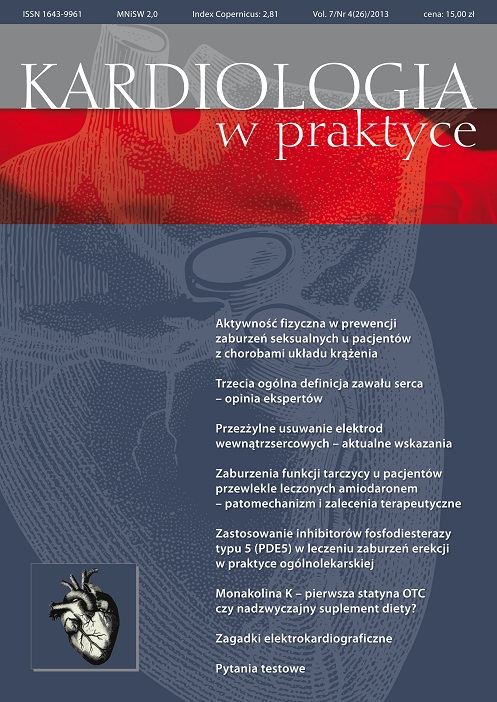The thyroid dysfunction during chronic amiodarone therapy – pathomechanism and therapeutic approach Review article
Main Article Content
Abstract
Amiodarone is a III Class Vaughan Williams antiarrhythmic drug. It is used for treating atrial fibrillation, atrial flutter and ventricular tachycardia and for preventing recurrence of atrial fibrillation in patients with structural heart disease. Amiodarone has a high affinity for adipose tissue and consequently has long lasting pharmacological effects in chronic treatment. One amiodarone tablet contains much more iodine than the optimal daily intake, thus chronic treatment may results in thyroid function disorders. The mechanisms in which amiodarone influences thyroid function are complex and include inhibition of type 1deiodinase enzyme activity, blocking cardiac TRα1 receptor for triiodothyronine, iodine-induced excess thyroid hormone synthesis and release (type 1 amiodarone induced thyrotoxicosis), inhibiting iodide oxygenation resulting in decrease in hormones production causing amiodarone induced hypothyroidism, and finally direct cytotoxic activity resulting in type 2 amiodarone induced thyrotoxicosis. From clinical point of view amiodarone induced thyrotoxicosis is of much more importance than hypothyroidism and is a real therapeutic challenge. Treatment strategies include pharmacotherapy with thionamides, potassium perchlorate or steroids or radical treatment – thyroidectomy or radioiodine therapy. Prior treatment with amiodarone several laboratory tests should be performed. In order to monitor thyroid function and identify treatment complications in form of thyrotoxicosis of hypothyroidism, regular thyroid function assessment is recommended up to 2 years after treatment discontinuation.
Downloads
Article Details

This work is licensed under a Creative Commons Attribution-NonCommercial-NoDerivatives 4.0 International License.
Copyright: © Medical Education sp. z o.o. This is an Open Access article distributed under the terms of the Attribution-NonCommercial 4.0 International (CC BY-NC 4.0). License (https://creativecommons.org/licenses/by-nc/4.0/), allowing third parties to copy and redistribute the material in any medium or format and to remix, transform, and build upon the material, provided the original work is properly cited and states its license.
Address reprint requests to: Medical Education, Marcin Kuźma (marcin.kuzma@mededu.pl)
References
2. Siuda K., Kolesińska Z., Niedziela M.: Amiodaron a funkcja tarczycy. Kard. Pol. 2011; 69(5); 493-498.
3. Klein I., Danzi S.: Thyroid Disease and the Heart. Circulation 2007; 116: 1725-1735.
4. Franklyn J.A., Gammage M.D.: Treatment of amiodarone-associated thyrotoxicosis. Nat. Clin. Pract. Endocrinol. Metab. 2007; 3(9): 662-666.
5. Bednarek-Tupikowska G., Filus A., Kuliczkowska J. et al.: Amiodaron a tarczyca. Post. Hig. Med. Dośw. 2004; 58: 216-225.
6. Kucharczyk P., Michałkiewicz D., Kucharczyk A.: Wpływ amiodaronu na czynność tarczycy. Pol. Merk. Lek. 2006; 21: 86-89.
7. Cohen-Lehman J., Dahl P., Danzi S. et al.: Effects of amiodarone therapy on thyroid function. Nat. Rev. Endocrinol. Metab. 2010; 6: 34-41.

